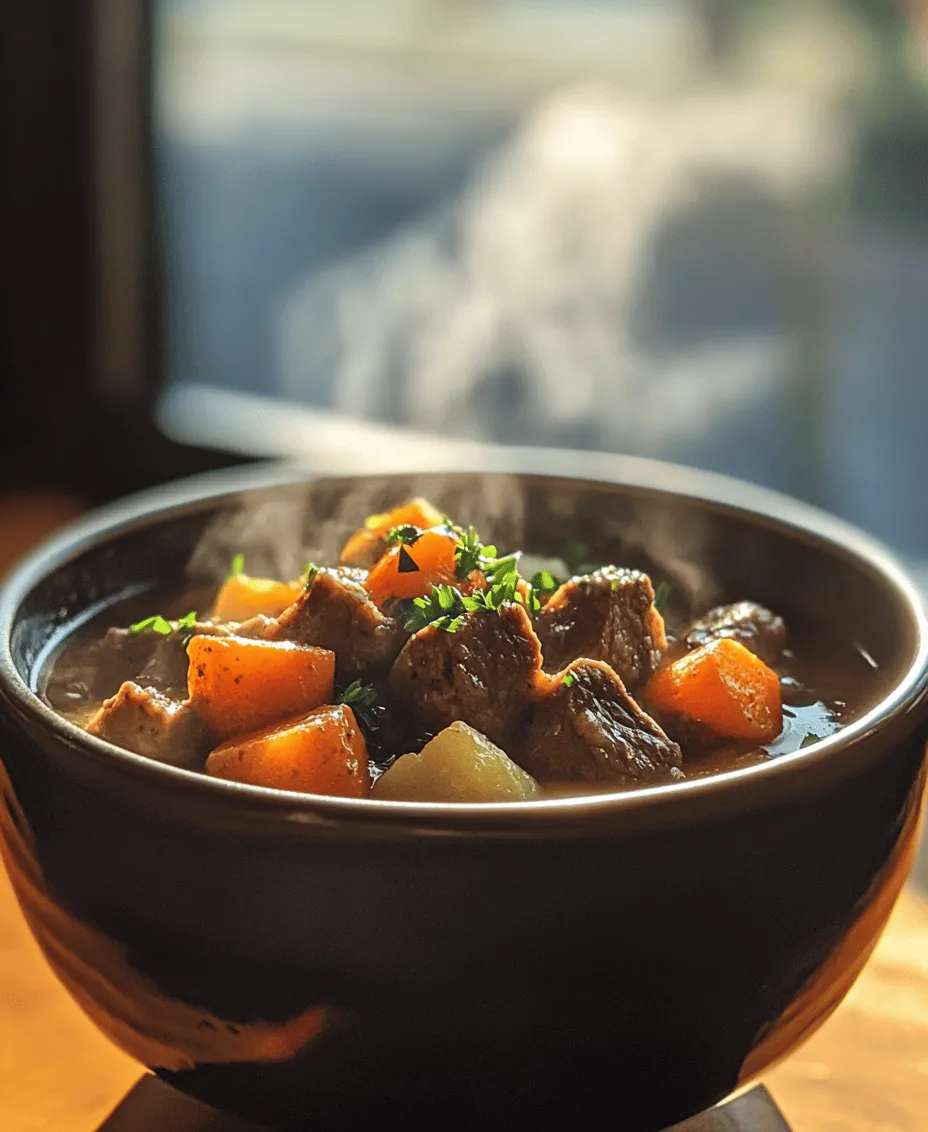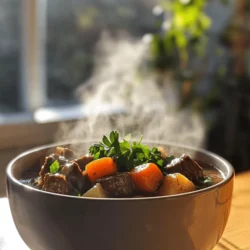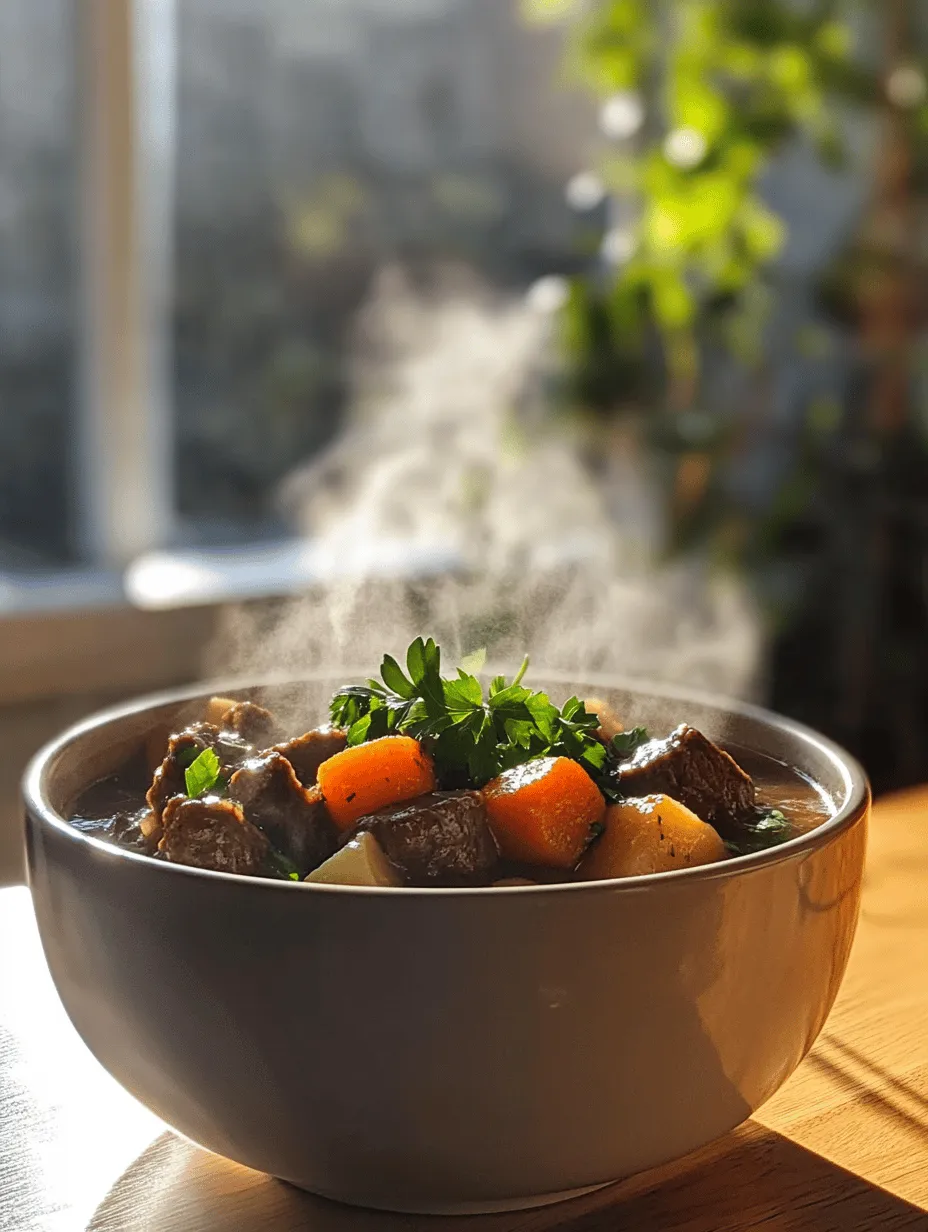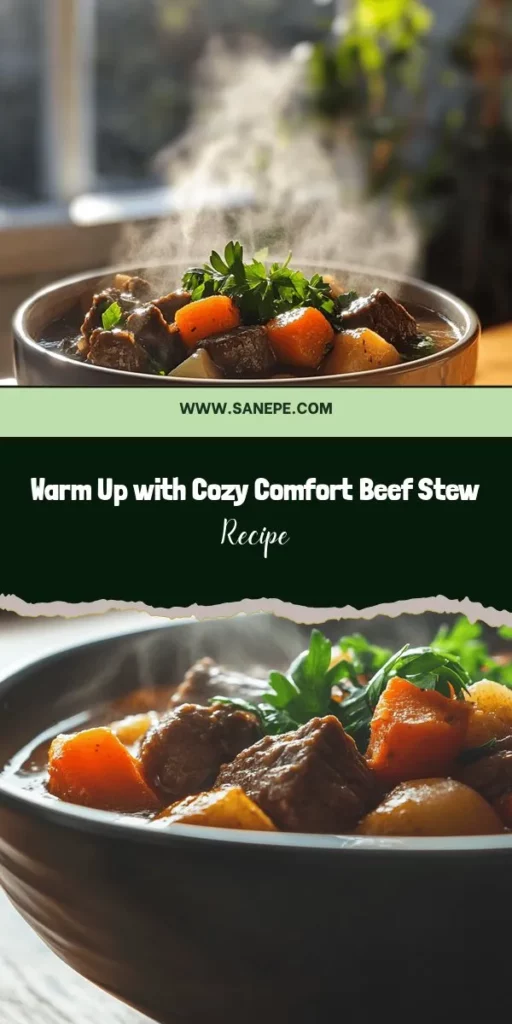Introduction
As the chill of winter settles in, there’s nothing quite like a warm, hearty meal to comfort the soul. The significance of comfort food during colder months is profound, as it not only warms our bodies but also nourishes our spirits. The Cozy Comfort Beef Stew stands as a quintessential dish that embodies this sentiment, offering a rich blend of flavors and textures that provide warmth and satisfaction with every spoonful. This dish is not only a staple in many households but also a beloved recipe that transcends generations.
The appeal of this beef stew lies in its simplicity and versatility, making it accessible to both novice and experienced cooks. With a few basic ingredients and straightforward preparation steps, anyone can whip up a pot of this delicious stew. Whether you’re hosting a family gathering or simply looking for a comforting meal after a long day, this beef stew is sure to become a go-to recipe in your kitchen.
Understanding the Ingredients
Before diving into the preparation, it’s essential to understand the key ingredients that make up this cozy dish. The foundation of a great beef stew lies in the quality of its components, so let’s explore each one.
Main Ingredients
1. Beef Chuck: The star of our stew is beef chuck, a cut known for its rich flavor and tenderness when cooked low and slow. Beef chuck is well-marbled with fat, which breaks down during the cooking process, resulting in melt-in-your-mouth meat. This cut is ideal for stews as it becomes incredibly tender and flavorful, enhancing the overall dish.
2. Fresh Vegetables: A variety of fresh vegetables plays a crucial role in both flavor and nutrition. Common choices include carrots, potatoes, onions, and celery. These vegetables not only add depth to the stew but also contribute essential vitamins and minerals, making each bowl a healthy choice.
3. Herbs and Spices: Seasoning is vital for elevating the flavors in the stew. Fresh herbs like thyme and rosemary add aromatic notes, while bay leaves impart a subtle earthiness. The use of black pepper and salt is crucial for balancing the flavors. For those looking to add a little extra warmth, a pinch of red pepper flakes can introduce a gentle heat.
Optional Ingredients
One optional ingredient that can enhance the stew significantly is red wine. Adding a splash of red wine not only deepens the flavor profile but also contributes acidity, which helps to tenderize the meat as it cooks. The alcohol content cooks off, leaving behind a rich, complex flavor that complements the beef and vegetables beautifully. If you prefer not to use wine, beef broth or stock can be substituted to maintain moisture and flavor.
Preparation Steps Explained
Now that we’ve covered the essential ingredients, let’s break down the preparation steps that will lead you to a deliciously cozy beef stew.
Step 1: Searing the Beef
The first step in creating a flavorful beef stew is searing the beef. This process involves cooking the beef chuck in a hot pan with a bit of oil until it develops a beautiful brown crust. Searing is crucial because it caramelizes the surface of the meat, creating complex flavors that will enhance the overall dish. Use a heavy-bottomed pot or Dutch oven for even heat distribution, and ensure the meat is patted dry before adding to the pan to achieve that perfect sear.
Step 2: Sautéing Vegetables
Once the beef is seared and removed from the pot, it’s time to sauté the vegetables. Begin with the onions, as they take longer to soften. Adding them to the pot will deglaze the bottom, lifting any flavorful browned bits left behind from the beef. After the onions become translucent, add the carrots and celery, allowing them to cook until tender. This step unlocks the natural sweetness of the vegetables, which will contribute to the overall flavor of the stew.
Step 3: Deglazing the Pot
After the vegetables have sautéed to perfection, it’s time to deglaze the pot. This step is essential for capturing all the rich flavors from the bottom. Pour in red wine (if using) or a bit of beef broth, scraping the bottom with a wooden spoon to lift any tasty bits stuck to the pot. This not only enhances the flavor but also ensures that your stew is packed with depth and richness.
Step 4: Adding Ingredients in the Right Order
Once you’ve deglazed the pot, it’s time to add the seared beef back in, along with the remaining ingredients. Begin by adding the beef broth to create a flavorful base. Then, toss in the potatoes, herbs, and bay leaves. It’s important to follow this order to ensure that everything cooks evenly and develops a harmonious flavor profile. Bring the mixture to a simmer, cover the pot, and let it cook low and slow. This allows the flavors to meld together beautifully, resulting in a truly comforting stew.
Timing and Cooking
The timing of each step is critical to achieving the perfect beef stew. Allow the stew to simmer for at least one and a half to two hours, or until the beef is fork-tender. During this time, the collagen in the beef will break down, creating a rich and velvety broth that coats the tender meat and vegetables. For an even deeper flavor, consider letting the stew simmer longer or even refrigerating it overnight; the flavors will intensify and develop further, making it even more delicious the next day.
By following these steps with attention to detail, you will create a Cozy Comfort Beef Stew that not only warms your body but also your heart. In the next part of this article, we will delve into the nutritional benefits of this hearty dish and how it can serve as a nourishing option during the colder months. Stay tuned for the delicious conclusion!

Cozy comfort beef stew is not only a delicious dish but also a complete meal that embodies warmth and satisfaction. This hearty stew is perfect for family dinners, gatherings, or even meal prep for busy weeks. Its rich flavors and tender chunks of beef combine with a medley of vegetables, making it a wholesome option that can stand alone or be beautifully complemented by various sides and beverages.
Serving Suggestions
To elevate your cozy comfort beef stew into a well-rounded dining experience, consider pairing it with side dishes that enhance its flavors. Here are a few ideas:
Side Dishes
– Garlic Mashed Potatoes: Creamy mashed potatoes infused with garlic provide a lovely contrast to the stew’s texture and absorb the savory gravy.
– Roasted Vegetables: Seasonal roasted vegetables such as carrots, Brussels sprouts, or parsnips add a pop of color and additional nutrients to your meal.
– Steamed Green Beans: Bright green beans seasoned with a touch of salt and pepper add freshness to the plate and balance the richness of the stew.
Bread Pairings
Bread is a staple that complements the hearty nature of beef stew. Here are some bread options to consider:
– Crusty Baguette: A freshly baked baguette with a crispy crust is perfect for dipping into the stew and soaking up the flavorful broth.
– Cornbread: Sweet, buttery cornbread offers a delightful contrast to the savory stew, making it a popular choice in many households.
– Whole Wheat Bread: For a healthier option, whole wheat bread provides a nutty flavor that pairs well with the stew’s richness.
Beverage Pairings
The right beverage can enhance the overall dining experience. Here are some suggestions:
– Red Wine: A full-bodied red wine, such as Cabernet Sauvignon or Malbec, complements the robust flavors of the beef stew beautifully.
– Light Beer: A crisp lager or pale ale can offer a refreshing balance to the dish.
– Non-Alcoholic Options: For non-drinkers, consider serving sparkling water with a twist of lemon or a rich apple cider that pairs well with the stew’s flavors.
Presentation Tips
When serving beef stew, presentation can elevate the meal:
– Use Rustic Bowls: Serve the stew in rustic, deep bowls to enhance the comforting vibe.
– Garnish: A sprinkle of fresh parsley or thyme adds color and freshness, making the dish visually appealing.
– Serve Family-Style: Present the stew in a large pot at the center of the table, allowing everyone to help themselves, fostering a sense of community.
Storing and Reheating Tips
If you find yourself with leftover beef stew, proper storage and reheating methods are essential to maintain its flavor and texture.
Best Practices for Storing Leftover Beef Stew
– Cool Quickly: Allow the stew to cool at room temperature for no more than two hours before storing it in the refrigerator.
– Use Airtight Containers: Store the stew in airtight containers to prevent moisture loss and spoilage, ensuring it remains fresh for up to three to four days in the refrigerator.
Recommended Storage Containers
– Glass Containers: Glass containers with tight-fitting lids are ideal for storing beef stew as they do not retain odors and can be reheated directly in the oven or microwave.
– Freezer Bags: For longer storage, consider using freezer bags, ensuring you remove as much air as possible to prevent freezer burn.
Tips for Reheating
– Stovetop Method: Reheat the stew gently on the stovetop over medium heat, stirring occasionally to prevent sticking and ensure even heating.
– Microwave Method: If using a microwave, transfer the stew to a microwave-safe container, cover it loosely, and heat in short intervals, stirring in between until warmed through.
– Add Liquid if Necessary: When reheating, if the stew appears too thick, adding a splash of beef broth or water can help restore its consistency.
Variations and Customizations
Beef stew is a versatile dish that can easily be adapted to suit dietary preferences or seasonal ingredients. Here are some variations and customizations to consider:
Vegetarian or Vegan Adaptations
– Mushroom Stew: Replace beef with hearty mushrooms, such as portobello or shiitake, which offer a meaty texture and umami flavor.
– Chickpea Stew: Use chickpeas as a protein source, adding various vegetables and spices for a satisfying vegan option.
Alternative Ingredients
– Different Meats: For a twist on the classic recipe, consider using lamb or pork instead of beef, each bringing its unique flavor profile.
– Plant-Based Proteins: Incorporate plant-based proteins like lentils or tempeh for a nutritious and filling stew.
Seasonal Vegetables
– Root Vegetables: In the fall and winter, add root vegetables like turnips or sweet potatoes for extra sweetness and texture.
– Spring Vegetables: In spring, consider adding asparagus or peas for a fresh touch.
Cultural Significance of Beef Stew
Beef stew has deep-rooted cultural significance in many communities around the world. Its origins can be traced back centuries, with variations found in cuisines from French bourguignon to Irish stew. The common theme among these dishes is their ability to bring people together around the table.
Historical Context
Throughout history, stews were often created as a way to utilize tougher cuts of meat, slow-cooking them to tenderness alongside available vegetables. This method not only maximized resources but also created a communal dish that was perfect for sharing.
Community and Togetherness
Comfort food like beef stew fosters community, bringing families and friends together for shared meals. Whether it’s a Sunday dinner, holiday gathering, or a simple weeknight meal, the act of cooking and sharing such a dish creates bonds and evokes feelings of warmth and nostalgia.
Conclusion
Cozy comfort beef stew is more than just a meal; it’s a heartwarming experience that invites you to savor every bite and share with loved ones. Its rich flavors and satisfying ingredients make it perfect for gatherings, while its adaptability allows for personalized touches that cater to your taste preferences.
As you embark on your culinary journey with this recipe, remember the joy of cooking and the warmth of sharing meals with family and friends. Whether you stick to the classic recipe or explore exciting variations, the cozy comfort beef stew is sure to become a cherished staple in your home. We encourage you to try this recipe and relish the comfort it brings to your table, creating memories and connections with each delicious bite.


